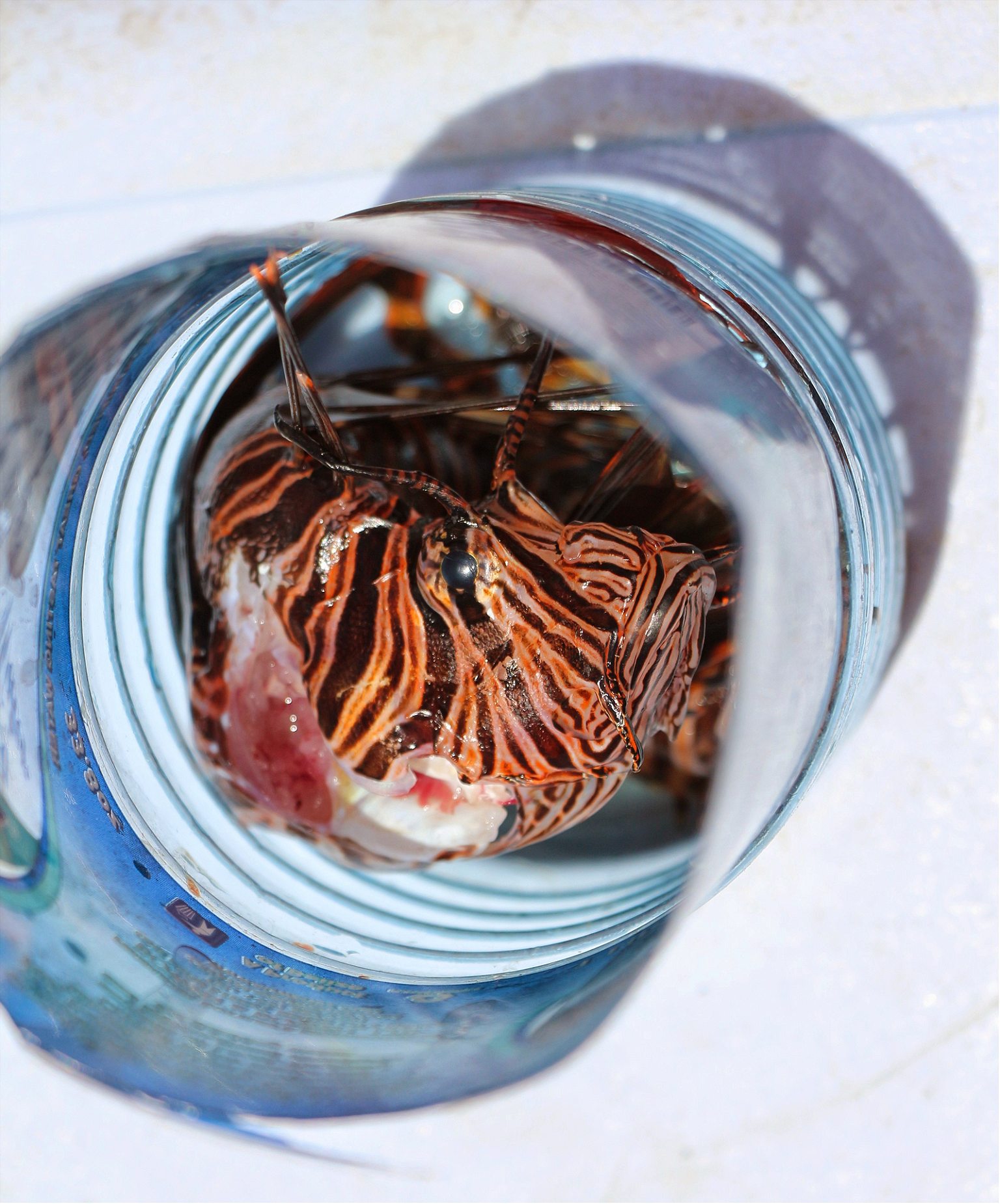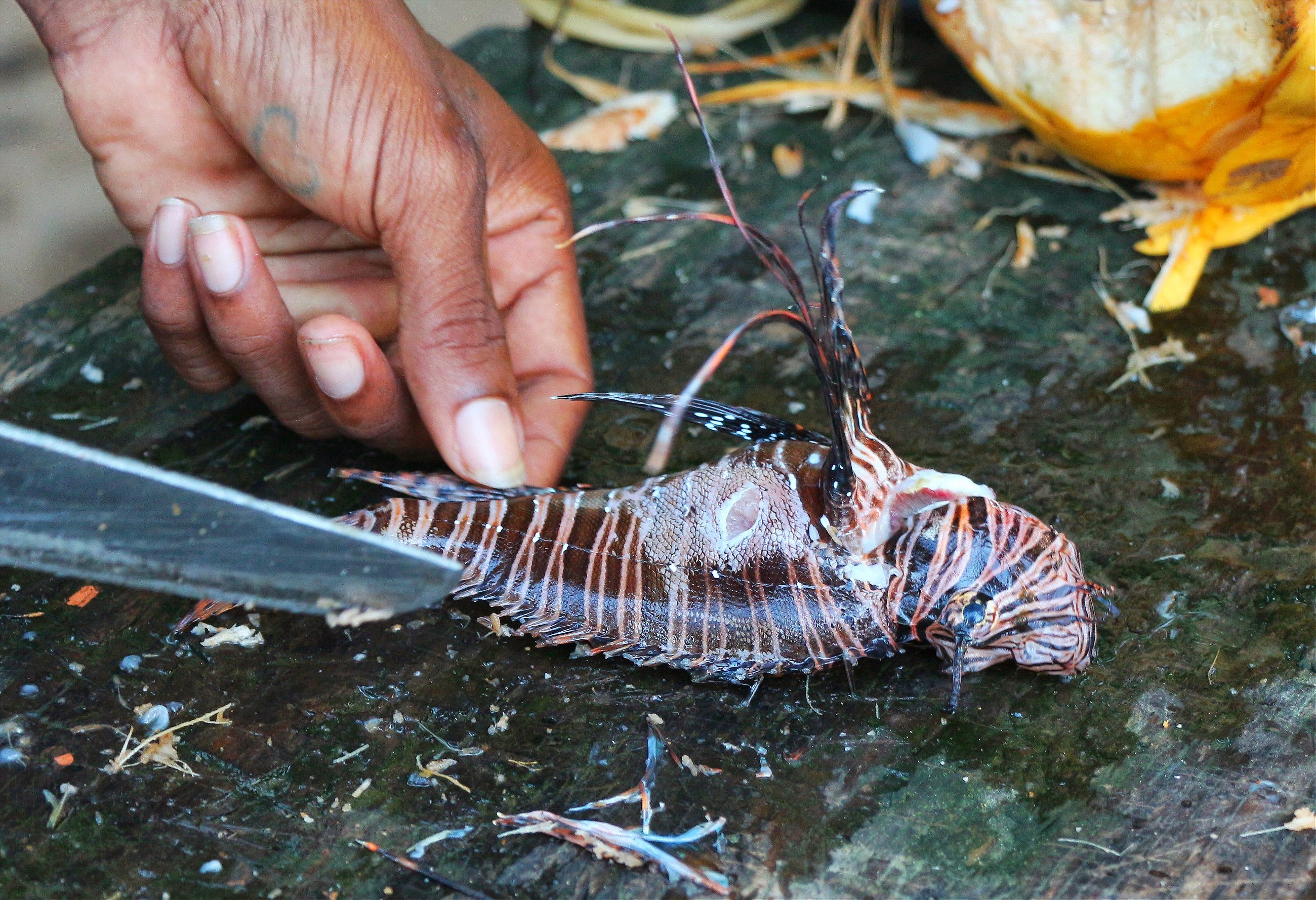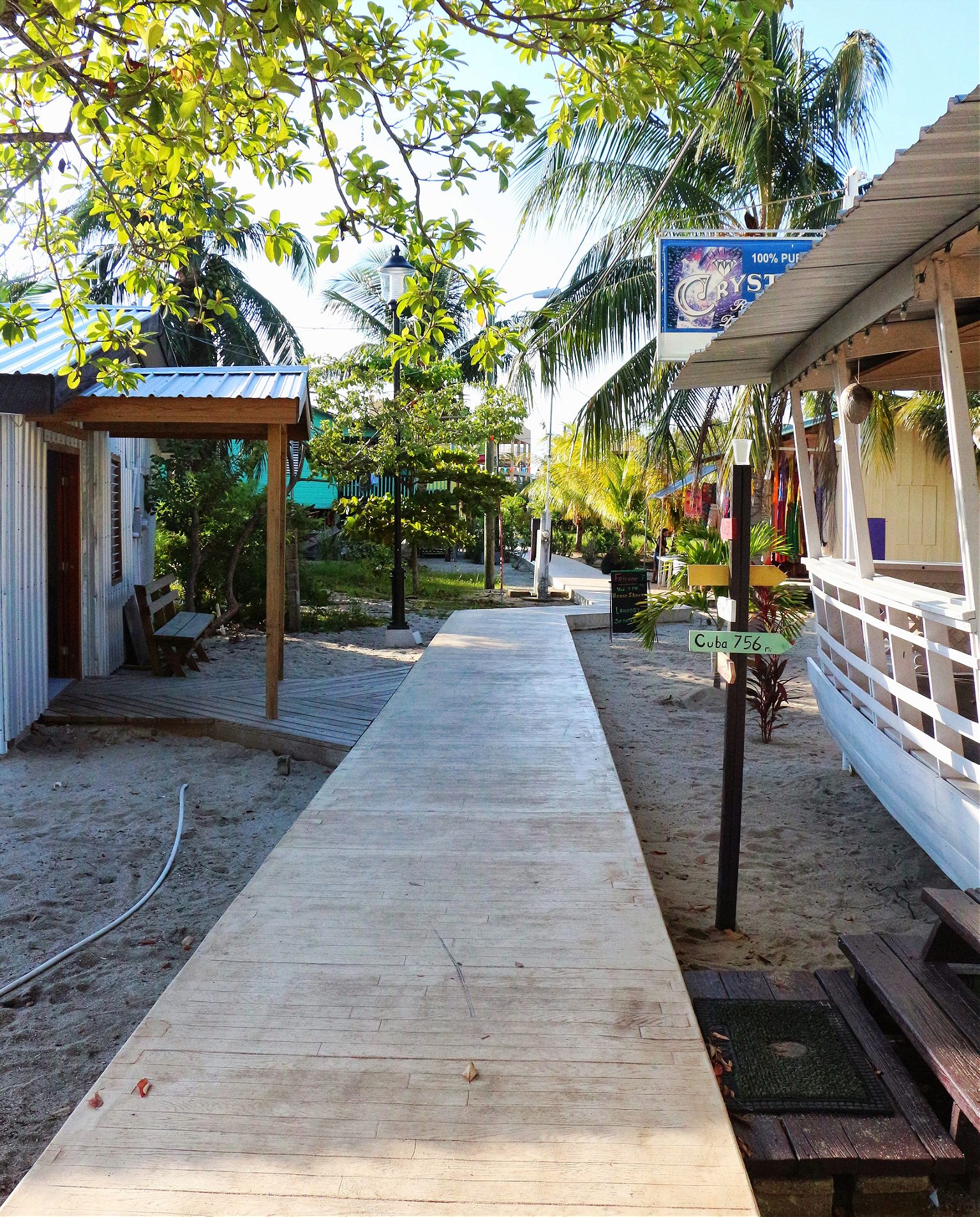An invasive species is devouring the native inhabitants of Belize’s reefs, and enterprising Belizeans are fighting back, in kind.
The burbles and pops of something frying grew louder, and so did the conflicting thoughts. Sitting across from my wife at an outdoor wooden table on Belize’s sandy Ambergris Caye, I was considering the conspicuous appearance of the lionfish. You can’t miss it: the fish’s long, feathery fins complement its venomous dorsal spines that thrust out like a Mayan headdress. It seems more drawn than grown. It’s the kind of haunting attractiveness you expect to find in endangered species, something that would be coveted for aquariums while its organs are carved up for black-market aphrodisiacs.
And I had just paid good money to eat it.
So had everyone else at the tables of the open-air Pirate’s Treasure Restaurant. While still popular in home aquariums, the lionfish is not endangered. Nor does its liver find its way into love potions.

Originally from the Western Pacific and the Indian Ocean, it is invasive in Caribbean waters, and is gobbling up native reef fish and mollusks with gruesome relentlessness. Each lionfish can consume prey up to half its size, a Joey Chestnut of the sea. They can mate every four days, and one female can produce two million eggs per year.
The lionfish, however, also happens to mate well with a dusting of flour and a deep fryer.
The idea of targeting invasive species with a dinner fork has gained attention since science writer James Gorman coined the term “invasivore” in a 2010 piece for the New York Times titled “A Diet for an Invaded Planet.” (The lionfish is the first species Gorman mentions.) The non-native wild boar of the American South often end up in sausage casings; restaurateur and James Beard Award nominee Bun Lai devotes a page in his menu to invasive species at his New Haven sushi restaurant. Louisiana chefs have experimented with the levee-wrecking nutria, a furry, twelve-pound vegetarian rodent originally from South America, but with limited success owing to the rodent stigma that holds back nutria from its full potential as an entrée. Being recognizable as a fish, the lionfish doesn’t suffer from such taxonomical hang-ups.

While lionfish has been turning up on menus across Belize’s coast, the Pirate’s Treasure Restaurant, connected to a series of bungalows called the Pirate Villas, is the only restaurant in Belize that serves lionfish as its only fish. “Ninety percent of my customers order lionfish,” owner Jason Gilbertson told us, “so I had to get rid of snapper.” Gilbertson is an Atlanta transplant whose Belizean girlfriend, Maresha Reid, is the restaurant’s head chef. Her specialty: piña colada lionfish, which despite sounding like a very unserious dish, is actually quite wonderful. The fish has a sweet caramelized coating from spending a night in a marinade of piña colada before being flambéed (Reid uses the whole drink, according to Gilbertson). Its flesh is firm but still moist, and surrenders willingly to the bite. At the same time, its flavor only differs in degree but not kind from other edible fish, making it an ideal ingredient for experimentation.

Jason gave us a lift back to San Pedro in his golf cart—the island’s de facto transportation. His dog Pirate, part pit-bull and part Labrador retriever, lay at his feet. As he navigated the cart around puddles in the dirt street, I asked him how he obtains the lionfish, since no other restaurant in San Pedro I had approached was currently serving it.
“I have divers on call,” he told us, a cigarette in the corner of his mouth ashing when we rode over the bumps. His divers employ the most effective method to date, using spear guns to pluck the invaders from the reef one by one. The diving team free dives and can spear about one hundred pounds of lionfish per outing, providing Reid with thirty to forty pounds of fillets.
THE ONLY THING SEPARATING ME FROM VENOM AND AGONY WAS A DISPOSABLE PLASTIC BOTTLE
Spearfishing for venomous creatures while holding one’s breath sounded like a challenging method of cleaning up the reef. I wanted to see how it was done.
I got my chance the following week in Hopkins, a hot, flat town spread along the center of Belize’s coastline, where I’d find that the only thing separating me from venom and agony was a disposable plastic bottle.
The lionfish’s joyride through the Caribbean and Western Atlantic began in 1992, when, according to legend at least, Hurricane Andrew smashed at least one waterfront aquarium in Florida containing lionfish.
Regulation has not yet caught up with the lionfish’s appetite, and its appeal to the aquarium enthusiast has not waned. On a recent check of the website of an American pet store chain, I noticed that the same species of lionfish that is ravaging Caribbean and Western Atlantic reefs, Pterois volitans, is still available with the caveat “Will eat any tankmate that can fit in its mouth.”
LIONFISH REDUCED THE JUVENILE FISH POPULATION OF ONE REEF BY 79% IN ONLY FIVE WEEKS
From those beginnings, it has already spread as far north as the Carolinas—not counting the odd, hopefully anomalous sighting off the coast of Rhode Island—and as far west as Belize, as far south as Panama, and as far east as St. Croix.
Native Caribbean predators such as the grouper and moray eel don’t recognize lionfish as prey, unless the lionfish is injured. Meanwhile, the lionfish recognizes any number of Caribbean reef fish as snacks.
The lionfish’s nature as a predator may seem contradictory to its size—adults rarely grow longer than 15 inches. But a study by Oregon State University revealed that lionfish reduced the juvenile fish population of one reef by 79% in only five weeks. These are the same reefs that provide jobs to fishermen and tourist guides, and also help protect coastlines of low-lying areas from storms and tidal forces. This is no smaller matter in Belize—the former capital Belize City, home to a quarter of the country’s population, lies almost entirely below sea level.
Colder sea water seems to be the only natural force stopping them in the Western Hemisphere. That leaves humans as the most promising line of defense.

Mounds of coral protruded like discarded Volkswagen beetles on the sea floor. I was following the snorkel fins of fisherman and guide Noel Nuñez, who was systematically scanning the crevices in the mounds, his three-foot spear gun gracefully extending his profile. Nuñez looks to be in his late thirties, and is of Garifuna heritage, a legacy of the descendants of Carib Amerindians who intermarried with survivors of wrecked slave ships in the eighteenth century.
While he was examining one side of the coral, I would examine the other, eyeing a rainbow of fish—wrasses, grunts, most of them smaller than bread plates—as they swam into covered archways under the coral mounds, into peek-a-boo channels, and around coffee-colored, elephant-ear vegetation gently flapping in the current.
After an hour of swimming near the shallows of the Blue Ground Range, part of Belize’s inner reef that lies ten miles east of Hopkins, we hadn’t seen a single sprawling fin or red zebra stripe of a lionfish.
Unlike other fishing trips, having a slow day of lionfishing was a good thing. Our difficulty meant that in the ten years since Belizean fishermen first started spotting lionfish, the fishermen have already succeeded at decimating the lionfish population in the shallows. Deeper depths, however, are another story, as scuba divers regularly report that lionfish abound at a depth of around 60 feet off Belize’s reefs.
Several towns, including San Pedro, host lionfish spearing competitions, whose award categories include the most lionfish speared, the largest lionfish, and the smallest.

In a smooth, unannounced motion, Nuñez dove under the surface and inserted his speargun into a narrow channel of a brain-shaped coral colony. A sharp snap broke the silence of the reef. He had released the trigger. He lifted the spear above the water to reveal a curled-up lionfish, wriggling for the last time. It spread out its striped fins in a slow, probing fashion and seemed confused that something had the audacity to attack it.
“How do you say ‘good shot’ in Garifuna?” I asked Nuñez.
“Buiti,” he answered, briefly pausing before swimming back to the boat. The catch was small—about seven inches—but Nuñez estimated that it was already three years old, two years past the age in which it had reached sexual maturity. There would be no mercy for the adolescents.
Judel, Nuñez’s son, had been manning the boat while Nuñez and I snorkeled. Nuñez said something to his son in Garifuna, and Judel began cutting the top off a plastic water bottle. Judel then lifted up the lionfish from under its mouth and dropped it inside the bottle to protect us from the venomous spines. The motion was fluid, almost casual. It was not his first time bottling a lionfish.
As Nuñez started up the outboard motor to change spots, I held the plastic bottle to keep it from tipping over. Almost as fast as the lionfish infestation began, diving companies started marketing protective gear for lionfish hunting such as puncture-resistant gloves and mesh-reinforced bags (one is nicknamed the Lionfish Hotel). But the bottle in my hand, its brand the same as the bottle I’d sipped from at breakfast, unceremoniously rose to the task, as long as I didn’t spill it.

I peered down inside the bottle. I was looking at a thing that had probably scarfed down hundreds of juvenile reef fish. Yet it was small enough so that the entire profile of its head fit sideways in the bottle. Its stubby antennae looked cartoonish. Brown and orange stripes ran under its eye, which was transparent except for a tack-like black pupil. It seemed to be frowning a child’s frown, playing the cute card, as if to say, “What did I do wrong?” I had already felt self-assured about preying on the reef’s self-assured predator, but as I appreciated the creature’s colors and curves up close, I realized that the killing and eating of lionfish could also safely feed a darker longing—the Fight Club-esque desire to destroy something beautiful. (The motivation, alas, has yet to be explored in the marketing materials of anti-lionfish campaigns.)
When we swam in a new spot, I employed Nuñez’s crevice-scanning technique, slowly floating above and examining all angles into each opening. Inside the first crevice, down about three feet, a one-foot lionfish was spreading its fins like a turkey, spinning leisurely. Perhaps it was hunting; the lionfish often stretches out its long fins to corner its prey. I yelled to Nuñez, who swam to me and began checking all the cave-like entries and exits in the twenty foot-wide coral mound.
After we examined each hole repeatedly, the fish did not reappear. “It’s hiding,” Nuñez said. We could do nothing but move on to a different spot.
Under the heavy heat of noon on the roofless boat, we nibbled on cold fried chicken thighs Nuñez had brought aboard in a cooler for lunch. I asked him if he was concerned about the lionfish’s venomous spines when he free drives. While the venom is not fatal (unless the victim has an allergic reaction), the resulting pain has been known to strike acutely and can linger for days. “They’ll get you good, especially when they are attacking you,” he said before chewing off another bite.
“What does it feel like to be stung by a lionfish?”
His answer: “Have you ever been stung by a scorpion?”
I SEARCHED IN VAIN FOR A COOK WHO KNEW HOW CLEAN LIONFISH WITHOUT GETTING STUNG
“This knife is sharp!” chirped Marley, Nuñez’s oldest son, as he swung a long chef’s knife onto a plywood table in his yard. The table, doubling as a cutting board, still held the remains of a coconut husk, cleanly halved, and now also held the lionfish on its side. Marley is a hip-hop music video producer, but in exchange for my assistance in helping to build his website, he had offered to clean the lionfish, a potentially dangerous task few in town would attempt. Before I had met Marley, I walked the length of the packed dirt road that serves as Hopkins’ main and only drag, searching for in vain for a restaurant cook who knew how clean lionfish without getting stung.
Marley had grabbed the fish out of the plastic bottle by its head just like his younger brother had done, cognizant of where the spines were and weren’t. With a few controlled snaps of his wrist, he chopped off the tips of all the dorsal spines, Marley’s bundled-up dreadlocks barely budging with each beat. “Only the tip of the spine has venom,” he said with calm confidence, as if he were holding a class.

The scales around the spear’s entry point had been shaken off by the impact. He scratched the rest of them off with the side of the knife. And with them went most of the striped coloring, revealing paper-white skin. For the lionfish, beauty is only scale deep.
I mentioned to him that we only saw one other lionfish during our outing. “Before, they were everywhere,” Marley said.
And then, the sobering dissection. “I always check the stomach when cleaning,” he said. It is a task that many lionfish hunters regularly perform, to better understand the abilities of the enemy. He carefully sliced open the greyish, oblong pouch inside the lionfish’s belly, revealing an equally grey two-inch fish. Its scales and fins had already been digested, making identification of the species difficult.
IT WAS AS IF AN ADULT HUMAN HAD JUST SWALLOWED A FOOTBALL IN ONE GULP
But the destructive power of the lionfish was unmistakable. Proportionally, it was as if an adult human had just swallowed a football in one gulp.
Therese Castillo, better known in Hopkins as Miss Therese, was picking limes from a tree in her backyard when I presented her with the plastic bag. The day before, my wife and I had met her (“Look for the woman selling bread at the bus stop,” we’d been told) and we had arranged to have her prepare a dinner of Garifuna dishes at her house in Hopkins, where she often cooks for guests and tourists.
My beach shoes sinking into the sand of her yard, I opened the bag to show her the lionfish, now filleted, along with a couple spiny lobsters and a hogfish that Noel had caught on the day’s fishing trip. She had prepared spiny lobster and hogfish countless times, but never lionfish. She looked into the bag.
“I’m gonna fry it.”

“People think Garifuna food is just rice and beans,” Castillo said as we all tore into the bounty in front of us: broiled spiny lobster tails; fried hogfish; fried lionfish; plantain dumplings in a thick coconut broth (a sweet, starchy traditional Garifuna dish); a pitcher of limeade; and a stew of gibnut, also known as paca, a cat-sized rodent prized in Central and South America for its porky flavor.
The lionfish was dwarfed by the hogfish on the plate, but both had a similarly light yet luxurious meatiness. The Garifuna had arrived to what is now Belize over two hundred years ago, long before the lionfish appeared, but Castillo had no difficulty figuring out how to cook up the newcomer. Without its venomous plumage, the lionfish is just another fillet to fry. I would not be surprised if fried lionfish ends up joining the canon of Garifuna cuisine.

The next day, when we arrived in Placencia, a peninsular town about an hour’s drive south of Hopkins, we found that outside a jewelry and gift store, a local artist had produced their own interpretation of the lionfish threat: a painting of a sultry, reclining mermaid with the fiery stripes and graceful fins of a lionfish. Dangerous beauty indeed.
We turned down the town’s sidewalk, a sort of raised boardwalk of concrete and wood planks running above the sand, and passed the faded clapboard of pole houses, until we found the Placencia Producer’s Cooperative. “BIGGEST LIONFISH: 744g; SMALLEST LIONFISH: 10g” read the handwritten poster, on the wall of the cooperative’s store, listing the results of Placencia’s 2013 Lionfish Tournament. A total of 599 lionfish had been speared by three competing teams of scuba divers in the nearby reef.

To encourage the spearing of lionfish while simultaneously offering local fishermen a worthwhile alternative to targeting overfished species such as grouper, the Cooperative began a project to purchase and process lionfish. The fillets would be shipped to restaurants in North America and beyond. The cooperative had just acquired its FDA license to proceed.
I met Justino Mendez, the operations manager, inside his windowless but heavily air-conditioned office, and asked him how the project was progressing. And where could I find the Cooperative’s lionfish served in the States?
“We’re at the promotion stage,” he told me. Unfortunately, no restaurants had served their fillets yet, because the Cooperative was still getting the word out to fisherman and importers/exporters alike. If Mendez has his way, though, in a few months’ time, we will be seeing blackened lionfish, lionfish pot pies, or lionfish sashimi on the menus of New York City, Chicago, and London restaurants. Lionfish is already being served in several South Florida restaurants, since Florida, whose waters are patient zero in the lionfish infestation, has already begun its own culinary campaign against the invader.

Can eating the problem make it go away? According to information gathered by the National Oceanic and Atmospheric Administration, scientists familiar with the life cycle of the lionfish are doubtful. The jaws of humans will never completely eradicate the species from the Caribbean and Western Atlantic. The lionfish is here to stay.
So we might as well enjoy it, guilt-free. Flambéed in a piña colada sauce. Or ceviched, as I’d had at the Hour Bar, a busy waterfront café in Belize City. Or perhaps you should enjoy it the way that seems to suit any fish in the sea: fried.